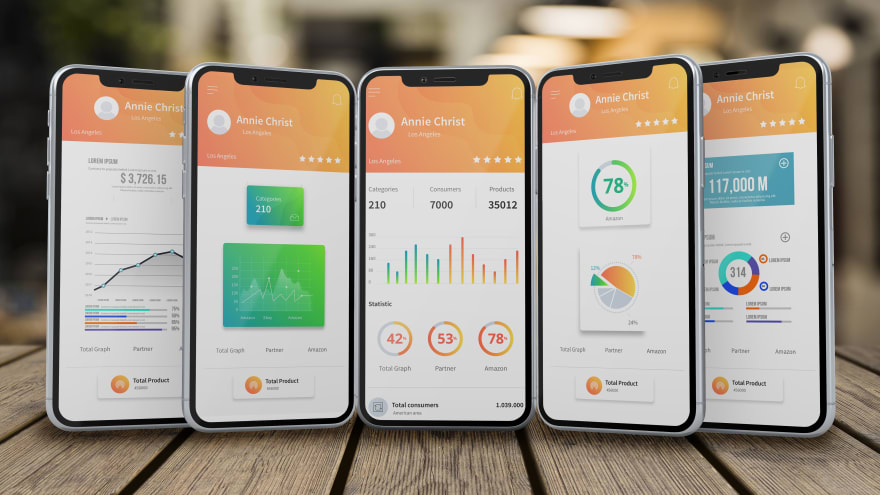With a mobile phone penetration rate of 83% in the US, offering a mobile app and finding a reputable mobile development company is key to being part of the still growing market. Building a mobile app takes a lot of time, budget and effort.
You can make this process much easier for yourself though, if you select the right mobile development company to do the work for you.
The question is how to find the best company for the task. What questions do you have to ask to separate the good app development companies from the bad?
To understand the world of mobile development and the pitfalls involved, I have made a comprehensive explanation and thoughts that should enable you to make the right choice.
Why do you need a mobile app?
The number of mobile phone users is growing every day. There is an estimated 5 billion users worldwide in 2020 out of approximately 8 billion people in the world. More than half the population is potentially reachable with your app.
A study found that 67% of people turn on their mobile phones within 5 minutes of waking up and the average person spends 3 ½ hours on their phone every day.
Why are people so addicted to their phones? Surprise, it’s not so they can be available at all times (even though that’s a perk for many). No, it’s because of mobile apps. Anything that can help a person and ease their workload just a little bit, or provide entertainment while you are waiting for someone or just being bored, is a blessing.
For businesses apps are a convenient way for them to offer their services and products in people’s homes. It’s also a great way to establish their brand and offer live customer service.
If you are a business owner and want either a new mobile app or update your current app to offer the latest features and functionalities of the current market, you should be looking for a great mobile development company to help you stay ahead of your competition.
Make the Mobile App Work for You
If you are still reading (I hope so!) it’s probably because you understand the importance of being a key player in the app market. Even though you are not going to make the app yourself, let’s get started by explaining the different technologies available and reasons for you to build an app.
There are two noteworthy operating systems available for app development today. Those two are Android and iOS. Microsoft tried for a short time to offer a Windows phone, but that has diminished a long time ago.
The number of app users for Android and iOS is almost 50/50, so you should target both systems when you build an app. You do this by building a hybrid app, also known as a cross-platform app.
Android offers an open system to its mobile app developers. That means the restrictions are a lot more lax than they are for iOS. That is both good because you can do a lot more with your app, for example offer features not available on iOS, such as network discovery, but it can also be bad because security is less safe on an open system.
iOS has a lot more restrictions on their OS. Their safety is top-notch because of this, but it also means there are apps not available on this OS that you can find on Android.
Generally, you will never be limited by either system when developing a mobile app, as most commonly used features are widely available on both devices.
Types of Mobile Apps
I briefly touched on creating a cross-platform mobile app above. While it is a great way to target both Android and iOS at the same time, there are other methods available. The 3 app development methods available are:
• Progressive Web Apps (PWAs)
• Native Apps
• Hybrid or Cross-platform Apps
Progressive Web Apps are delivered through the web and not stored on the device. They are built using HTML, CSS and JavaScript and can be used on any device offering a mobile browser. They are easy to update and you only have to build one version for both Android and iOS users. However, PWAs do not have access to the more advanced functionalities of the devices, so there are limitations on what you can use them for.
PWAs are also not governed and featured in the App Stores which can be both good, because you don’t have to meet specific guidelines, but bad because you lose the audience of the app stores.
Native apps are developed specifically on the OS they are going to run on, so in this case Android and iOS. Their advantage is that you can take full control of all native features of the device and are not limited by the other platform’s lack of support. These apps are featured on app stores and must meet the guidelines of either Google or Apple. They are also stored on the device itself, therefore not necessarily dependent on a network connection to work.
Hybrid apps or Cross-platform apps are much like native apps. They are fast and also installed on the device(s). You only have to build one app to target both devices. By doing mobile development using this method, you can save on cost.
What Are the Benefits of a Mobile App for both Android and IOS?
The main benefit is to developing an app for both platforms is that you target the entire mobile market at the same time. If Android only had a 10% market share and iOS 90% it would make sense to consider if the cost was worth it to develop for Android, but since they share the market pretty close to evenly, you should build for both platforms.
How to Find the Best Mobile Development Company
You can choose to outsource building an app to a contractor, but it’s unusual they can manage the whole process themselves, so you’ll have to hire a whole team and do the overseeing of the development. If you are not already well versed in app development, it is probably not something you are able to. I’d recommend you instead look for a mobile development company.
To find the app company can be a tedious process. There are so many parameters to consider. What’s their history, their portfolio, the reviews, success rate, cost and much more.
1: You could use a search engine and start looking up companies. Put in “mobile app development company” and you’ll get a lot of results. But who’s say the top listings are the best company? They are not listed by quality on a search engine, rather their SEO efforts or ad budget.
Instead you might want to check two of the best pre-vetted company directories. They are Clutch.co and UpCity. Being B2B research-and-review directories, they are focused on offering the best app development company for you. In fact, they offer directories for a wealth of different digital offerings, such as websites, SEO and – of course – app development.
Both Clutch and UpCity has a rigorous process to prevent abuse and distrust. For example, companies listed cannot submit their own client reviews. Instead, clients are required to submit their own reviews after passing a thorough validation process by either phone or LinkedIn.
When a review goes live the company cannot remove it. Therefore, the reviews tend to be honest and trustworthy.
2: You might also consider location a factor. It’s important to be able to get hold of the company you want to work with. A lot of companies are located in India for example, but have store fronts in the US making it seem like they operate on US soil. There’s nothing wrong with outsourcing to another country, just be sure communication will not be an issue.
The good thing about outsourcing instead of going local is the talent pool grows massively. In this day and age, you can easily set up an online meeting with audio and video and it works as well as being in the same room. It’s just cheaper and faster to set it up, ultimately saving your dollars by not having to pay the hidden fees through the mobile development process for your app.
3: Once you have decided on a company, be sure to examine their website thoroughly.
a. Do they have any mobile app development case studies?
b. Do their designs look great or more like template designs?
c. Do they have an app development process listed to clearly define each phase?
d. Are they able to develop both Android and iOS apps?
Contacting a Mobile Development Company
When you have looked through your options and selected a few companies you want to contact after looking at the mobile app development pages and checked off your list, here are some things to look out for.
Contact them either by phone or their contact page on their website. Have your questions ready and provide a budget if you feel comfortable with that. Often providing a budget is a good idea as you will quickly find out if it’s enough to work with them, so you don’t waste your time.
Ask about their app development phase and possibly examples of how they usually work during an app development project.
If you are asking them for a quote be specific of what you need. The more detailed you can describe your app project, the more precise your quote will be. Telling them you want a social app for people to meet on with pictures and text is not going to give you a very precise quote as they will have little to work with.
Ask if they provide NDAs. An NDA is important to protect you from having your app idea stolen and reliable mobile development companies shouldn’t have an issue with this.
The Mobile App Development Process
You are now in the final stage of developing your app for the mobile market. At this point you have researched the app development companies, narrowed down your choices, interviewed your candidates and selected the chosen mobile development company.
It’s time to get started on your exciting venture. But before you do so, I would recommend reading the guide by Inspire Visual, a mobile development company, called “How to Launch an App – The Definitive Guide”. It goes through each step of the process in lay-men terms.
App Stores and Technical Information
After you have developed your mobile app and have published it to the app stores, it will be featured in the App Stores. Google has their own Android app store and Apple has their app store.
38 Steps on How to Publish an Android App
First you need the APK file, which is the source file of you app. The mobile development company can provide you with this file.
- Create a Google Play Developer account. It cost $25 and is a one-time fee.
- In the Google account, click All Applications and Create application.
- Select your Default language, enter your app Title and click Create.
- Go to the Store Listing tab.
- In Product Details enter the Short and Full description of your app.
- In Graphic Assets, choose the Hi-res icon and click + Add to add a high-res icon. It should be 512×512.
- In Phone add your screenshots, click Browse Files to add screenshots of your app. You must add at least two screenshots of your app. You can also add screenshots for Tablet, Android TV and Wear OS if you target those devices.
- In Feature Graphic, click + Add to add a feature graphic. This image will be displayed at the top of your Store Listing page in the Play Store.
- You can also add a Promo Graphic and a Promo Video (link to YouTube video) to promote your app, but this is optional.
- In Categorization, select your Application Type, Category, and Content Rating.
- In Contact Details, enter your Website, Email and Phone number (optional).
- In the Privacy Policy section you have to enter the privacy policy URL of your application (can be hosted on your website)
- Click Save Draft.
- Then click on the App releases tab, and Manage.
- Select Create release.
- OPT-OUT of the Google Play App Signing.
- Next, click Browse Files and locate your APK file to upload.
- Once the file has uploaded, click Save.
- Select the Content Rating tab and review the information, then click Continue.
- Enter your app’s contact email address.
- Select your mobile app’s category and complete the questionnaire.
- Save your questionnaire.
- Select Calculate Rating and select Apply Rating.
- Click the Pricing & Distribution tab
- Select the User programs (usually Google Play for Work)
- Select your app’s type, whether it’s Free or Paid. Note: If you publish a paid app, you must add a merchant account to your Google Play Account. Also, once you have published your app as Free, it is not possible to change to a Paid model.
- Go to Countries and select Available to distribute your app in all regions. You can also select specific countries to target from the list.
- In Contains Ads, you have to select if your app contains ads or not.
- Next is User Programs. Here you can choose to opt-in to the Google Play for Education option (optional). Also consider Consent to the Marketing opt-out option (optional).
- In Consent you have to read the Android Content guidelines, then select the check-box to acknowledge that your app meets Google’s guidelines.
- Click the App content tab and select START.
- Choose the age group of your target demographic and click on Next.
- Answer whether or not your app target children under 13.
- Make sure App release, store listing, content rating, app content and pricing and distribution all have green checkmarks.
- Go back to App releases and click on Edit release.
- Select Review.
- Click Start rollout to production.
- Finally, click on Confirm and your app will become available to all users of the Play Store.
27 Steps on How to Publish an iOS App
- Create an Apple Developer Program. It cost $99 for a one-year subscription membership.
- Log in to your new Apple Developer account.
- Generate an ID for your app.
- Go to Certificates, Identifiers and Profiles menu.
- In the left Menu, click on Identifiers. Click the + icon to create a new identifier.
- Select the first option and then Continue.
- Create your Bundle ID and be sure it matches the one you have in your XCode project. XCode is your app development kit. Apple suggests your Bundle ID be: country abbreviation + .com + organization + . + app name.
- When you have completed the steps above, the identifier appears on the app list with the XC wildcard.
- In XCode, go to Project Navigator. It’s the first icon on the left menu with an icon of a folder. Here, you need to ensure two main things are correct: the app Version and Build.
- If this is your first app launch, leave the default version to 1.0. Increase this number every time you make a new app archive.
- Go to the Product Menu.
- Select Archive and then the archive you just made.
- Click Distribute App.
- Leave the options default, unless you have specific requirements.
- Back in your Apple Developer account, go to the App Store Connect menu and click it.
- Go to the top left menu and select My Apps.
- Add a New App.
- Select iOS version.
- Name your app the official name it will have in the App Store.
- Select Primary Language and the Bundle ID created earlier in XCode.
- Choose an ID for your app (not visible in the App Store).
- Click Create.
- In the App Information section, fill out the information about your app, including App name, Category and Description.
- Add a URL to your Privacy Policy. This can be a page hosted on your website.
- Go to Pricing and Availability and choose a Free or Paid model.
- Go to Submit for review and provide screenshots and previews of your app. Provide a 5.5” screenshot for iPhone 8 Plus and smaller, a 6.5” screenshot for the iPhone XR and finally a 12.9” screenshot for the iPad Pro.
- Save your app and submit for review.
Once you have uploaded your app, it’s important to address any issues and feedback you get from your users. Both app stores offer review sections and you can find valuable feedback, including bugs encountered, annoyances or feature suggestions.
Maintaining a high review score is equally as important as that will impact how likely users are to download your app compared to your competition.











Top comments (0)
Some comments may only be visible to logged-in visitors. Sign in to view all comments.